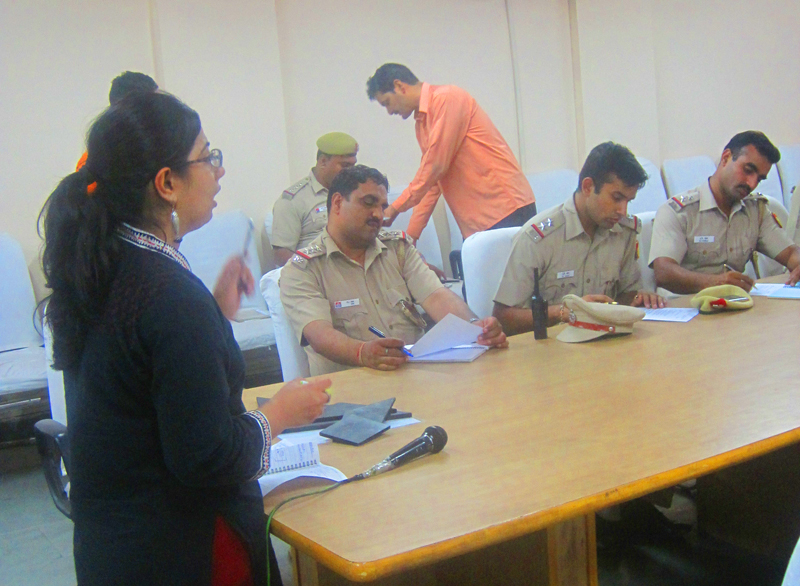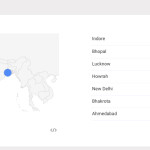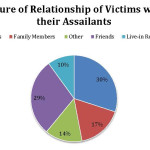Centre for Social Research (CSR), Crisis Management Centre, Usmanpur organized a Gender Sensitization Training at the Seemapuri Police Station on 13th October, 2015. The training was facilitated by Ms Pratishtha Arora, trainer with Gender Training Institute accompanied by Ms Smriti Sharma. It specifically focused on the need for Gender Sensitization and effective communication skills amongst the Delhi Police in regard of Missing persons and Unidentified Dead Bodies. The training was initiated with an introductory note on the organization and their expectations from the same. It also comprised of activity sessions in order to engage them and simultaneously comprehend their ability to assess what was being discussed.


The audience consisted of police personnel within a mixed age group. The training began with laying down the significance of understanding the distinction between ‘sex’ and ‘gender’, if the issue at hand was gender sensitization. Thus, they were asked what they understood by the terms Sex and Gender; and whether they thought both were the same. Amongst a largely silent group, one police personnel explained that both the terms denoted the male-female binary, associating them with the same meaning. To elucidate that both had different connotations they were illustrated that ‘sex’ meant biological difference between men and women, qualified by visible physical characteristics. Apart from the fact that men can clad sarees and ‘play’ the role of a woman, they cannot perform the biological function of reproduction that only women can. This signifies ‘sex’, which is static. In opposition, ‘gender’ is social, that which society gives us in terms of roles, responsibilities, attributes, dress, behavior patterns to distinguish between men and women, classifying them as masculine and feminine. For instance, from the beginning attributes such strong, unemotional, competitive are associated with boys/men, while attributes such as gentle, docile, emotional, caretakers are seen as being female specific. Moreover, specific colors such as blue and pink; toys such as guns and dolls are associated with boys and girls respectively. In order to gauge that they grasped what had been elucidated, Ms Pratishtha conducted an activity wherein an exercise sheet was distributed among the police personnel. The exercise sheet comprised of sentences against which they had to tick whether they associated the particular sentence with sex or gender. Each personnel were given five minutes to do the same after which it was taken up for discussion. One was elated to know that a majority of them had been able to decipher the distinction between sex and gender.
This was followed by another activity session called the ‘Tanagram’ which consisted of wooden pieces of different shapes and sizes; and a sample picture as a guide to how the pieces had to be arranged. A group of three women were chosen and three men volunteered to participate in the activity. The women were told to give instructions to the men as per the image provided to them, who then based upon the instructions had to arrange the pieces. The rules of the activity were threefold; the women had to face backwards and give instructions; they were only allowed to give instructions in Hindi and lastly could only refer to the image given. In the time given, the women instructed the men to place the different shapes (square, rectangle, rhombus, triangle) sequentially starting from the top. In observing them what we largely heard the women say was “Sabse pehle chokor laga do, phir trikon lagado, phirse trikon, phirse chokor, phirse trikon aur phir rhombus”.


Surprisingly, the two teams did not interrogate each other to assess how the wooden pieces had to be arranged. They did not concern themselves with the different sizes of the pieces. Hence, the outcome was in contradistinction to the image provided. In an activity aimed at comprehending the communication skills of the police personnel, there was a paucity of mutual understanding amongst the teams. Therefore, this scenario was an ideal case of lack of communication amongst the two parties and as Ms Pratishtha put it “Isse ek doosre ki baat adhuri reh jaati hai”.( There is lack in terms of what both parties are trying to communicate) In light of this activity, Ms Pratishtha hypothesized that if a woman comes to report a domestic violence case and there is weak communication between the police and aggrieved woman, in terms of both parties not probing into the matter; and there only being one-way communication then, they have failed in their ability to convey the issue at stake. Thus, what is required is that there be continuous questioning and probing in the matter by both parties involved.
In a session, where the issue at stake was Gender Sensitization, the discussion proceeded to the concept of patriarchy. Ms Pratishtha elucidated that patriarchy implies male domination, where the male is seen as the head of the household possessing decision making powers. Firstly, in India after marriage, the woman acquires patrilocal residence i.e. she goes to the man’s house. Nonetheless, this practice is only observed in North India. If one were to see Northeastern India, their social structure is matriarchal and form residence is matrilocal (man comes to the woman’s house after marriage). In Northern India, a man abiding to such a practice is labelled as ghar jamai and mocked at. Secondly, in terms of ‘gender roles’ if a man was told that he sit at home, while the woman earns for the family, then he would be subjected to ridicule. With respect to the same, a dissenting police inspector claimed that men and women have different roles to play. In the light of this statement he said “Iss area (Usmanpur) mein lady constables kaam hi nahin kar paati, kyunki idhar zyadatar momdons hai”(In Usmanpur, the lady constables fail to function because the area is highly volatile due to its large majority being momdons). In response, Ms Pratishtha said that if such a scenario existed then male police personnel could accompany them providing a sense of support. Prior to this, the ‘tanagram’ activity also directed towards the same solution that was given here i.e. better communication. In continuance with ‘gender roles’, it was discussed that if one were to look at the routine activities of a man and woman, then women experience what is termed as ‘double day’, wherein they have dual responsibility of the household and workplace. Moreover, if we move beyond the household into the different institutional arenas (i.e. education, law, etc) we observe that in the educational sector, girls drop out at the age of 13-14 on a large scale. Nonetheless, as police personnel mentioned that there has been a change in statistics with an increase in percentage from 20% to 80%. In the legal sphere, most of our laws are oriented towards women which are largely an outcome of varied cases (domestic violence, rape, dowry, sexual harassment) that have occurred with women. Therefore, the need of the hour is that there exist a mutual understanding between men and women, thwarting the idea of exclusive work; and working towards equality and restructuring of gender relations.
The last part of the session pertained to the concern with ‘Missing Persons and Unidentified Dead Bodies’. The discussion began with individual experiences of police personnel in a situation if a ‘Missing Persons and Unidentified Dead Bodies’ case was registered. In unison all claimed that there exists a set of norms that needs to be followed. The main steps undertaken in case of an unclaimed dead body are identification of the body, publication in the newspaper, referring and informing the National Crime Records Bureau (NCRB) and Human Rights Commission, taking finger prints, DNA samples and also performing the funeral rites if required. Moreover, they also look into the social background of the concerned person and if circumstances require, as one policeman mentioned, they deviate from the modus operandi and do what they think is necessary at that point in time. In a situation of a missing person case being registered, the police trace the missing person through his/her call and text transactions via cellphone. They also publish a section in the print/electronic media informing the public with his/her identification specifications. In response, Ms Pratishtha raised the concern whether in today’s time social media would be a faster way of reaching out to the public in case a missing person case was registered. A majority of them agreed that social media is definitely a faster way of communicating with regard to any issue. A significant component of the discussion was that the police repeatedly raised their apprehension with respect to a large number of children running away from their homes on account of petty issues. Therefore, the importance of counselling or the discipline of psychology being a part of the school curriculum was stressed. Nevertheless, a policeman exclaimed that the implementation of the same is difficult because the education level at Usmanpur is astounding low. Moreover, it lacks infrastructure amongst an extremely dense population.
The training session finally concluded with an interactive round, wherein Ms Pratishtha answered to the questions that the police raised regarding the Crisis Management Centres (CMC) run by CSR. Ms Pratishtha illustrated that these centres provide legal aid and counselling sessions to women in distress. The police were also concerned with whether they could direct cases pertaining to women facing any form of violence to the CMC’s. Moreover, did CSR have shelter homes for women? Mr Nadeem, the counsellor at the Usmanpur CMC exclaimed that they could guide them to shelter homes and courts if any woman desired so. The training ended with the hope that the police would work towards enhancing their communication potential and develop a nuanced understanding of gender violence issues that were reported to them.
Discuss this article on Facebook




